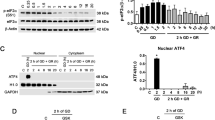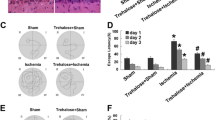Abstract
It has been shown that NAD+ availability is important for neuronal survival following ischemia (Liu et al., Neuromolecular Med 11:28–42, 2009). It is proposed here that NAD+ may also control proteotoxicity by influencing both formation and catabolism of altered proteins. It is suggested that low NAD+ availability promotes synthesis of methylglyoxal (MG) which can induce formation of glycated proteins, ROS, and dysfunctional mitochondria. That glyoxalase overexpression and carnosine are both protective against MG and ischemic injury support this proposal. Recognition and elimination of altered proteins is enhanced by NAD+ through effects on stress protein expression and autophagy.

Similar content being viewed by others
References
Ahmed, N., Battah, S., Karachalias, N., Babeai-Jadidi, R., Horanyi, M., Baroti, K., et al. (2003). Increased formation of methylglyoxal and protein glycation, oxidation and nitration in triosephosphate isomerase deficiency. Biochimica et Biophysica Acta, 1639, 121–132.
Aldini, G., Maffei-Fracini, R., Beretta, G., & Carini, M. (2005). Carnosine and related dipeptides as quenchers of reactive carbonyl species: From structural studies to therapeutic perspectives. Biofactors, 24, 77–87. doi:10.1002/biof.5520240109.
Alhamdani, M. S., AlKassir, A. H., Abbas, F. K., Jaleel, N. A., & Al-Tace, M. F. (2007). Antiglycation and antioxidant effect of carnosine against glucose degradation products in peritoneal mesothelial cells. Nephron. Clinical Practice, 107, c26–c34. doi:10.1159/000106509.
Anderson, R. M., Barger, J. L., Edwards, M. G., Braun, K. H., O’Connor, C. E., Prolla, T. A., et al. (2008). Dynamic regulation of PGC-1α localization and turnover implicates mitochondrial adaptation in caloric restriction and the stress response. Aging Cell, 7, 101–111.
Baykara, B., Tekman, I., Pekcetin, C., Ulukus, C., Tuncel, P., Sagol, O., et al. (2009). The protective effects of carnosine and melatonin in ischemia-reperfusion injury in the rat liver. Acta Histochemica, 111, 42–51. doi:10.1016/j.acthis.2008.03.002.
Brownson, C., & Hipkiss, A. R. (2000). Carnosine reacts with a glycated protein. Free Radical Biology & Medicine, 28, 1564–1570. doi:10.1016/S0891-5849(00)00270-7.
Cai, W., He, J. C., Zhu, L., Chen, X., Zheng, F., Striker, G. E., et al. (2008). Oral glycotoxins determine the effects of calorie restriction on oxidant stress, age-related diseases and lifespan. American Journal of Pathology, 173, 327–336. doi:10.2353/ajpath.2008.080152.
Carini, M., Aldini, G., Beretta, G., Arlandini, E., & Facino, R. M. (2003). Acrolein-sequestering ability of endogenous dipeptides: Characterization of carnosine and homocarnosine/acrolein adducts by electrospray ionization tandem mass spectrometry. Journal of Mass Spectrometry, 38, 996–1006. doi:10.1002/jms.517.
Celotto, A. M., Frank, A. C., Seigle, J. L., & Palladino, M. J. (2006). Drosophila model of human inherited triosephosphate isomerase deficiency glycolytic enzymopathy. Genetics, 174, 1237–1246. doi:10.1534/genetics.106.063206.
Cunningham, J. T., Rodgers, J. T., Arlow, D. W., Vazquez, F., Mootha, V. K., & Puigserver, P. (2007). mTOR controls mitochondrial oxidative function through a YY1-PGC-1α transcription complex. Nature, 450, 736–740. doi:10.1038/nature06322.
Desai, K. M., & Wu, L. (2008). Free radical generation by methylglyoxal in tissues. Drug Metabolism and Drug Interactions, 23, 151–173.
Dobrota, D., Fedorova, T., Stvolinsky, S., Babusikova, E., Likacanova, K., Drgova, A., et al. (2005). Carnosine protects the brain of rats and Mongolian gerbils against ischemic injury after stroke. Neurochemical Research, 30, 1283–1288. doi:10.1007/s11064-005-8799-7.
Fouad, A. A., El-Rehany, M. A., & Maghraby, H. K. (2007). The hepatoprotective effect of carnosine against ischemia/reperfusion liver injury in rats. European Journal of Pharmacology, 572, 61–68. doi:10.1016/j.ejphar.2007.06.010.
Fujii, T., Takaoka, M., Tsuruoka, N., Kiso, Y., Tanaka, T., & Matsumura, Y. (2005). Dietary supplementation of L-carnosine prevents ischemia/reperfusion-induced renal injury in rats. Biological and Pharmaceutical Bulletin, 28, 361–363. doi:10.1248/bpb.28.361.
Gnerer, J. P., Kreber, R. A., & Ganetzky, B. (2006). Wasted away, a drososphila mutation in triosephosphate isomerase, causes paralysis, neurodegeneration and early death. Proceedings of the National Academy of Sciences of the United States of America, 103, 14987–14993. doi:10.1073/pnas.0606887103.
Guix, F. X., Ill-Raga, G., Bravo, R., Nakaya, T., de Fabritis, G., Coma M, et al. (2009). Amyloid-dependent triosephosphate isomerase nitrotyrosination induces glycation and tau fibrillation. Brain, 132, 1335–1345.
Hipkiss, A. R. (2003). Do developmentally-related changes in constitutive proteolysis affect aberrant protein accumulation and generation of the aged phenotype? Mechanisms of Ageing and Development, 124, 575–579. doi:10.1016/S0047-6374(03)00005-8.
Hipkiss, A. R. (2006). On the mechanisms of ageing suppression by dietary restriction—is persistent glycolysis the problem? Mechanisms of Ageing and Development, 127, 8–15. doi:10.1016/j.mad.2005.09.006.
Hipkiss, A. R. (2008). Energy metabolism, altered proteins, sirtuins and ageing: converging mechanisms? Biogerontol, 9, 49–55. doi:10.1007/s10522-007-9110-x.
Hipkiss, A. R. (2009a). On the enigma of carnosine’s anti-ageing actions. Experimental Gerontology, 44, 237–242. doi:10.1016/j.exger.2008.11.001.
Hipkiss, A. R. (2009b). Error-protein metabolism and ageing. Biogerontology. doi:10.1007/s10522-008-9188-9.
Hipkiss, A. R., & Chana, H. (1998). Carnosine protects proteins against methylglyoxal-mediated modifications. Biochemical and Biophysical Research Communications, 248, 28–32. doi:10.1006/bbrc.1998.8806.
Hipkiss, A. R., Michaelis, J., & Syrris, P. (1995). Non-enzymic glycosylation of the dipeptide L-carnosine, a potential anti-protein-cross-linking agent. FEBS Letters, 371, 81–85. doi:10.1016/0014-5793(95)00849-5.
Kumagai, T., Nangaku, M., Kojima, I., Nagai, R., Ingelfinger, J. R., Miyata, T., et al. (2009). Glyoxalase-1 overexpression ameliorates renal ischemia-reperfusion injury in rats. American Journal of Physiology. Renal Physiology, 296, F912–F921. doi:10.1152/ajprenal.90575.2008.
Kurata, H., Fujii, T., Tsutsui, H., Katayama, T., Ohkita, M., Takaoka, M., et al. (2006). Renoprotective effects of L-carnosine on ischemia/reperfusion-induced injury in rats. Journal of Pharmacology and Experimental Therapeutics, 319, 640–647. doi:10.1124/jpet.106.110122.
Lee, I. H., Cao, L., Mostoslavsky, R., Lombard, D. B., Liu, J., Bruns, N., et al. (2008). A role for the NAD-dependent deacetylase Sirt1 in the regulation of autophagy. Proceedings of the National Academy of Sciences of the United States of America, 105, 3374–3379. doi:10.1073/pnas.0712145105.
Liu, D. L., Gharavi, R., Pitta, M., Gleichmann, M., & Mattson, M. P. (2009). Nicotinamide prevents NAD+ depletion and protects neurones against excitotoxicity and cerebral ischemia: NAD+ consumption by SIRT1 may endanger energetically compromised neurons. Neuromolecular Medicine, 11, 28–42. doi:10.1007/s12017-009-8058-1.
McFarland, G. A., & Holliday, R. (1994). Retardation of senescence in cultured human diploid fibroblasts by carnosine. Experimental Cell Research, 212, 167–175. doi:10.1006/excr.1994.1132.
Min, J., Senut, M. C., Rajanikant, K., Greenberg, E., Bandagi, R., Zemke, D., et al. (2008). Differential neuroprotective effects of carnosine, anserine and N-acetylcarnosine against permanent focal ischemia. Journal of Neuroscience Research, 86, 2984–2991. doi:10.1002/jnr.21744.
Morcos, M., Du, X., Pfisterer, F., Hutter, H., Sayed, A. A., Baynes, J., et al. (2008). Glyoxalase-1 prevents mitochondrial protein modification and enhances lifespan in Caenorhabditis elegans. Aging Cell, 7, 260–269. doi:10.1111/j.1474-9726.2008.00371.x.
Nicolay, J. P., Schneider, J., Niemoeller, O. M., Artune, F., Portero-Otin, M., Hair, G., Jr., et al. (2006). Stimulation of cell suicide by methylglyoxal. Cellular Physiology and Biochemistry, 18, 223–232. doi:10.1159/000097669.
Oya, T., Hatton, N., Mizuno, S., Maeda, S., Osawa, T., & Uchida, K. (1999). Methylglyoxal modification of protein. Chemical and immunochemical characterization of methylglyoxal-arginine adducts. Journal of Biological Chemistry, 274, 18492–18502. doi:10.1074/jbc.274.26.18492.
Rabbani, N., & Thornalley, P. J. (2008a). The dicarbonyl proteome: proteins susceptible to dicarbonyl glycation at functional sites in health, aging and disease. Annals of the New York Academy of Sciences, 1126, 124–127. doi:10.1196/annals.1433.043.
Rabbani, N., & Thornalley, P. J. (2008b). Dicarbonyls linked to damage to the powerhouse: Glycation of mitochondrial proteins and oxidative stress. Biochemical Society Transactions, 38, 1045–1050. doi:10.1042/BST0361045.
Rajanikant, G. K., Zemke, D., Senut, M. C., Frenkel, M. B., Chen, A. F., Gupta, R., et al. (2007). Carnosine is neuroprotective against permanent focal cerebral ischemia in mice. Stroke, 38, 3023–3031. doi:10.1161/STROKEAHA.107.488502.
Salminen, A., & Kaamiranta, K. (2009). SIRT1: Regulation of longevity via autophagy. Cell Signalling (in press). doi:10:1016/jcellsig.200902.014.
Schneider, A. S. (2000). Triosephosphate isomerase deficiency: Historical perspectives and molecular aspects. Bailliere’s Best Practice & Research. Clinical Haematology, 13, 119–140. doi:10.1053/beha.2000.0061.
Seidler, N. W. (2000). Carnosine prevents glycation-induced changes in electrophoretic mobility of aspartate aminotransferase. Journal of Biochemical and Molecular Toxicology, 14, 215–220. doi:10.1002/(SICI)1099-0461(2000)14:4<215::AID-JBT6>3.0.CO;2-Z.
Sejersen, H., & Rattan, S. I. (2009). Dicarbonyl-induced accelerated aging in vitro in human skin fibroblasts. Biogerontology, 10, 203–211. doi:10.1007/s10522-008-9172-4.
Shinohara, M., Thornalley, P. J., Giardino, I., Beisswenger, P., Thorpe, S. R., Onorato, J., et al. (1998). Overexpression of glyoxalase-1 in bovine endothelial cells inhibits intracellular advanced glycation endproduct formation and prevents hyperglycemia-induced increases in macromolecular endocytosis. Journal of Clinical Investigation, 101, 1142–1147. doi:10.1172/JCI119885.
Tang, S. C., Arumugam, T. V., Cutler, R. G., Jo, D. G., Magnus, T., Chan, S. L., et al. (2007). Neurpoprotective actions of a histidine analogue in models of ischemic stroke. Journal of Neurochemistry, 101, 729–736. doi:10.1111/j.1471-4159.2006.04412.x.
Thornalley, P. J. (2008). Protein and nucleotide damage by glyoxal and methylglyoxal in physiological systems–role in aging and disease. Drug Metabolism and Drug Interactions, 23, 125–150.
Westerheide, S. D., Anckar, J., Stevens, S. M., Jr., Sistomen, L., & Morimoto, R. I. (2009). Stress-induced regulation of the heat shock factor 1 by the deacetylase SIRT1. Science, 323, 1063–1066. doi:10.1126/science.1165946.
Author information
Authors and Affiliations
Corresponding author
Rights and permissions
About this article
Cite this article
Hipkiss, A.R. NAD+ Availability and Proteotoxicity. Neuromol Med 11, 97–100 (2009). https://doi.org/10.1007/s12017-009-8069-y
Received:
Accepted:
Published:
Issue Date:
DOI: https://doi.org/10.1007/s12017-009-8069-y




